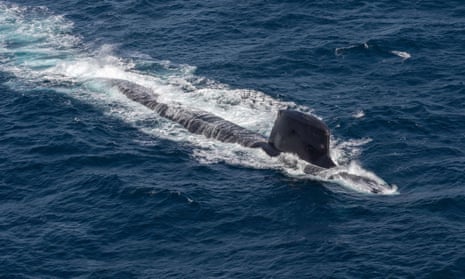The former Coalition government knew the now-dumped submarine project would likely cost about $80bn when it told the public the price tag would be “greater than $50bn”, an audit report has found.
In a new report tabled in parliament on Tuesday, the Australian National Audit Office found the 2016 defence investment plan “fell short of providing accurate, reliable and transparent information” to the public.
The Department of Defence defended the significant difference between the public and private figures, telling auditors it had been trying to protect commercial “sensitivities” when the submarine project was still open to tender.
At issue is the cost of the now-dumped Attack-class submarine program.
The French bid for the diesel-electric submarine project was later selected, only to be scrapped last year in favour of a nuclear-powered option under the Aukus deal with the US and the UK.
The ANAO said the public version of the integrated investment program – published at the same time as the 2016 white paper – put the total price tag as “greater than $50bn” over the period 2018 to 2057.
But the audit report said the “cost advised to government in February 2016 was $78.18bn”, or 56% higher than the minimum reported publicly.
That was also similar to the $79.8bn figure that appeared in a classified document dated March 2016 that was also viewed by the ANAO.
The same report said the publicly reported cost of another major project – the Hunter-class frigates – was “greater than $30bn”. But the confidential figure known to government, $36bn, was 20% higher than that minimum. All used the same accounting standards.
The ANAO tried to find out why defence had adopted these minimum figures, rather than setting out a range between two numbers as it had with other projects.
But it said defence records “do not document the decision or rationale” for this reporting method, and the department had been unable to find any official record of the decision.
Defence also told the ANAO in February this year – when the Coalition was still in power – that both the submarine and frigate projects had still been subject to competitive evaluation processes in 2016.
“As such a more conservative banding was published to mitigate commercial and foreign affairs sensitivities for those active tenderers engaging with the Commonwealth,” defence told the ANAO.
But the ANAO said this explanation was lacking.
“The parliament and community rely on the release of accurate and meaningful cost information by defence, as a basis for informed scrutiny and discussion on its acquisition activity,” the report said.
after newsletter promotion
The ANAO audit was broader than the submarine and the frigate projects.
Auditors examined the two public editions of the integrated investment plan, which outlined a range of major defence projects for the decades ahead.
One of these plans was released in 2016 with the Turnbull government’s defence white paper, and the other was released in 2020 alongside the Morrison government’s defence strategic update.
But the ANAO found that for these two public editions, “there was no guidance to officials on how to report publicly, and the transparency and usability of the public editions was reduced”.
These problems included “making it difficult to identify projects and track between public editions; omitting certain projects or aggregating projects without some explanation of the approach adopted; and using different approaches to report potential costs without explaining why”.
The report described the administration of the program since 2016 as “partly effective”.
Defence accepted five of the six recommendations, including ensuring a reporting system that provides confidence that public reporting is accurate and transparent.
But it rejected a call to ensure that the department include in any public reports on the investment program a progress update “showing projects cancelled, amalgamated, slipped in timing, changed in title, scope or cost”.
Defence said any future public release of the Integrated Investment Program “will be subject to consideration by government and will consider National Security implications as well as commercial sensitivities”.
